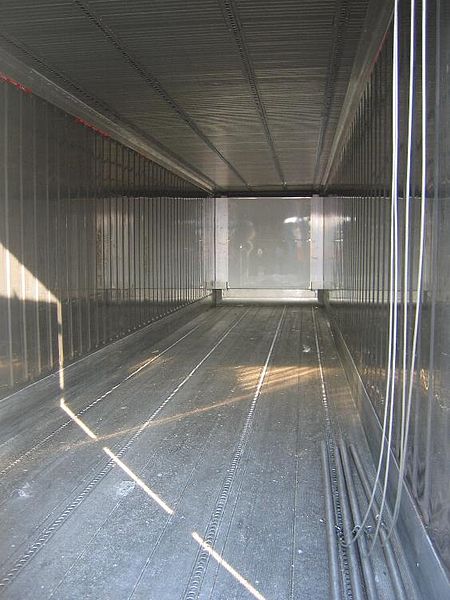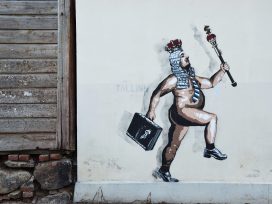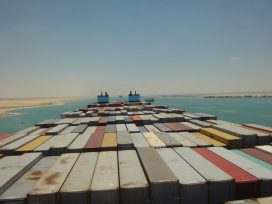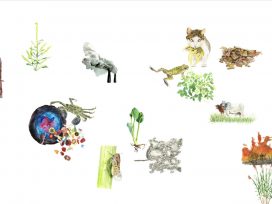Where to find the precariat? David Simon’s legendary TV series The Wire continues to offer incomparable insights into life in the time of neoliberalism. In ethnographic slow motion, The Wire narrates how the population of Baltimore falls through the safety nets of a crumbling welfare system, aggregating into a new class subjugated to the doctrine of Adam Smith’s Wealth of Nations, gospel of drug baron and property speculator Stringer Bell. In one unforgettable episode, Baltimore dockers open a container only to back away from the sweetish stench and terrible sight. Nineteen bodies are stacked in the blue box, nineteen young women from eastern Europe, suffocated to death. In this scene, the opposite poles of the global labour market that define the precariat confront each other. On one hand, the trade in human beings that ends in death, on the other, waged work with job security and social rights, something that ever more people are prepared to die for. Baltimore’s highly organized dockers, who have watched in despair as they are slowly replaced by machinery, are brought face-to-face with the nineteen women who, driven by the same desperation, have let themselves to be locked into a container.
The concept of the precariat was first used to address emergent conditions in the postindustrial western world. In a lecture in 1997, Pierre Bourdieu asserted that “the precariat is everywhere”, observing that insecure and short-term jobs are becoming more common, making life itself insecure, restless and hard to plan – in a word, precarious. The causes for this transformation were generally sought at the economic level of society; many social scientists identified these causes with what is known as globalization – although I am not sure we really always know, exactly, what is known by that term.
I will come back to this later. Let me first clarify the term itself. Often, “the precariat” is frequently used to signify a familiar scenario. Ivor Southwood catches the flavour of it in his Non-Stop Inertia. Jobs become fewer, rougher, more dangerous, worse paid and shorter lasting. Even the unemployed are forced to work – to tinker with their CVs, fight off rivals and tart themselves up to attract the attention of Human Resources. Our labour markets are increasingly offering the opposite of what most people want – to lead orderly, predictable lives within their community. This precludes all kinds of social bonding except one: loyalty to the employer. If you want work, you must be prepared to prioritize your employer over your family, children, home, health, holidays, education, dreams and expectations of the future.
“There is a lot of anger and anxiety out there”, concludes Guy Standing in his book The Precariat. His thesis is that the precariat is a new global class in the making. It is constituted by seven kinds of work-related insecurities, which is to say that members of the precariat lack some or all of the following: (1) labour market security, i.e. adequate income-earning opportunities, epitomized at the macro-level by a government commitment to “full employment”; (2) employment security, i.e. regulations on hiring and firing, imposition of costs on employers for failing to adhere to rules and so on; (3) job security, i.e. ability and opportunity to retain a niche in employment, plus barriers to skill dilution and opportunities for “upward” mobility in terms of status and income; (4) work security, that is, protection against accidents and illness at work, through, for example, safety and health regulations, limits on working time, and unsociable hours; (5) skill reproduction security, i.e. opportunity to gain skills through apprenticeships, training and so on; (6) income security, provided by, for example, minimum wage machinery, wage indexation, comprehensive social security and the like; and (7) representation security, i.e. a collective voice in the labour market, for example independent trade unions with a right to strike.
Do you lack any of these? Then your life is precarious in certain aspects. Do you lack several or all of these? Then you have joined the precariat. Up to a quarter of the population of some countries already belong to the new class, according to Standing. It includes culture workers, lone traders and small businesses, people without proper documents or without work, shift or part-time workers, seasonal workers, students, refugees, migrants and many, many others.
Not everyone agrees that the precariat is a distinct class; some think that “precarization” bridges and crosses class boundaries, although the most clear-cut effects are seen at the bottom level. The workers’ movement successfully strove to build a state and a legal system in which waged work, regulated by agreement, constituted the foundation for true access to citizens’ rights, social justice and democracy. It follows that precarization will cause this foundation to crumble: work will then lose its political dimension and turn into a private transaction between two “partners”. Because of the often breath-taking inequality between them, the worker will be ruthlessly exploited. The outcome is a stratified labour market, in which only an elite of blue- and white-collar workers can count on staying within “the salariat”, as Standing calls it. Meanwhile, ever growing numbers of outsiders will be oiling the wheels of the service economy and staffing the world’s manufacturing industries.
Another outcome is the re-emergence of something we had relegated to the past: poverty. To take my own Sweden – still a privileged country, but no longer the incarnation of social justice: statistics now show that more than every fourth child living with a single parent is poor. Of those who immigrated to Sweden from non-European countries in the last decade, more than half are poor. Precarization affects people more severely if they lack personal networks and informal routes into the employment marketplace, which is why it hits people and groups differently depending on gender, class and ethnicity.
So far, I have dwelt only on definitions. In many ways, the term “precariat” appears as the sociological equivalent of the “multitude” in political science, which in turn is related to the “subaltern” of post-colonial theory, which in its turn touches on the “proletariat” of Marxism, which was an analytical definition of still more diffuse terms such as “the masses” and “the poor”. Do these words amount to anything more than different ways of identifying one and the same underclass? Do they perhaps point us toward some new definition of “the people”? If so, do these words provide different images of the subject and substratum of democracy? To be sure, a huge task of conceptual elaboration lies ahead before “the precariat” may become a truly useful concept.
Yet instead of asking what or who constitutes the precariat, the more appropriate question is, surely: why are we so excited about it at this particular moment? Two corollaries of this question would address, first, whether the term is politically useful and, second, in what ways it helps us identify new social patterns.
As for the first question, it might be suggested that the precariat has become an issue of our time because it indicates a shift between North and South. We all know that belief in the West as subject of history has lost much of its viability. Today, it is no longer Europe that sets itself up as a model for the Third World, but the other way round. This can be seen with particular clarity in the world’s metropoles or global cities, which – as Saskia Sassen has argued – have lost their national anchorages and become socially divided along “global” lines. Large parts of the rural areas of the world are also becoming “global” in the same sense; for instance, when northern European berries are no longer picked by the locals but harvested by temporarily enslaved foreign workers. How long before Swedish youth, or at least its coloured elements, are dragooned into that workforce and commandeered to berry harvesting in Norrland or other rotten jobs currently done by seasonal crews from Thailand and Vietnam? That one can easily imagine a near-future film with such a plot means that the scenario already exists as an ideological option in the present.
Here we approach a connection that is insufficiently clarified in discussions about the precariat. It might be said that this discussion is a sign of the fact that radical popular movements as well as critical sociologists have abandoned their delusions and started to confront the real consequences of the western world’s subjection to the same global capitalism that previously only operated without constraints in other parts of the world. In large parts of the West, workers’ movements succeeded in regulating the labour market, distributing company profits and eradicating poverty. This created an island of welfare, social justice and equality in an ocean of capitalist and colonial inequality. It appeared as if poverty had been made to disappear, although in fact it had only been relocated. At the very moment when the welfare state was constructed in Europe and North America, other parts of the world were suddenly categorized as poor and “underdeveloped”.
Of course, this is a simplification – but a reasonable one. Colonized peoples fought for freedom and forced the colonial powers to recognize, at least on paper, the rights of all men to equality and self-determination. However, at the very moment that the colonized refused to work unpaid for the white man and declared themselves his equals, the white man introduced another discourse. This emphasized that the newly created states, although equal, were backward, underdeveloped and – according to economic measures introduced after 1945 – poor. This poverty implied that the white world should continue “developing” these states much in the same way as the white world already had been doing for centuries, although previously this had been justified by the duty and responsibility that followed with its racial superiority.
Even economists of the neoliberal school – indeed, they above all – admit that it is in the nature of capitalism to create wealth through the creation of poverty, and that it creates poverty in order to create wealth. This is why Marxists have consistently demanded the abolition of capitalism. This is also why most others have demanded, as a minimum requirement (and along the lines of Karl Polanyi), that capitalism must be embedded, that is, constrained by regulations aiming to redistribute the wealth that capitalism has created to those suffering from the poverty arising as a result of the very same process.
For the last three decades, however, the scenario has been the opposite one: a neoliberal regime that has managed to embed society in capitalism. Its proponents recommend that European welfare societies subordinate themselves in the same way as the rest of the world. There, politics has long served to motivate the release of the market in pure form, exposing people and the environment to the wealth-producing forces of capitalism. These forces must not be blocked by artificial political measures; the poor must accept their poverty as a consequence of the wealth accumulated by the rich, thus turning resignation into economic necessity.
The consequences are grotesque. As I write, the bonus payments to the CEO of the Scandinavian bank Nordea have just been announced: around 2 million euros (20 mill SEK), including a pension entitlement of around 10 million euros (100 million SEK). At the same time, the Swedish right-of-centre Centre Party has proposed a 25 per cent cut in the entry wages of new employees. The fundamental management precepts operating in this instance are in fact analogous to those applied to slave labour on American plantations. Beat the slaves more often, reduce the age for sending children out to work on the fields, and the yields will improve. The rich get richer and the poor get poorer. In the eye of the rulers, this no longer counts as malfunction but as a sign that the system is working as it should, as the American cultural critic Richard Dienst has argued.
What are the poor to do? Career planning, coaching, cognitive behaviour therapy, shopping around for the right schools, taking up apprenticeships and accepting lower starting pay, these are some of the solutions on offer. In sum, poverty is supposed to fix itself through intensified competition, in which the poor are expected to outdo one another on the labour market. One person’s poverty is thus absolved by increasing that of someone else.
And if they fail to compete? Why, that’s entirely their problem. It’s because they haven’t been trying hard enough. They are unsuitable, by nature or nurture lazy and ruined by benefit dependency. The elite will point the finger at them as the Africans of the western world, unless they are bullied and called white trash, a dumped lot of outsiders, members of an underclass which, in addition, is blamed for the rise of populism and racism throughout Europe.
“Our poverty will be our greatest export”, commented a Philipino film maker in the 1980s. He was referring to his country’s method of improving its trade balance by obliging millions of its poor to take up slave-like labour in ship chandling, tourism and other service jobs. Poverty is exportable. Europe once knew it, but seems to have forgotten. Sweden sent a million poor to America. European economies grew strong because poverty could be displaced to other zones. This inevitable by-product of capitalism.
These days, poverty is one of the West’s largest imports. Governments assure us that we must carry on importing poverty in order to support growth, competitiveness, welfare and, yes, wealth. The process will not end until conditions for ourselves are the same as those of the millions of hard-working Chinese seamstresses and assembly line workers, or the equally numerous Africans working on Spanish, Italian and Dutch vegetable plantations.
All of which leads us to question concerning the usefulness of “precariat” as a political term. It may be a massive generalization, but like all generalizations it stimulates thinking about interconnections. At best, the notion of the precariat might make us more aware of the unity between working people and injustices we have in common. Guy Standing claims that the precariat is a new political subject. Its first and self-evident political demand is a citizen’s wage. The precariat, he argues, makes visible the common ground between natives and migrants, as well as the connections between, say, the Swedish economy and the everyday life of Philipino housemaids, African seasonal labourers and Chinese factory workers who handle the worst jobs in the global economy.
Migration and precarization are intimately related. The worldwide decline in working conditions is driven by specific policies of immigration and emigration that enable maximal extraction of the surplus value generated by work carried out by undocumented migrants without rights. The slave plantations are no longer somewhere in the tropics, but right here in our midst, as part of an expanding informal economy upon which ever more people rely for their survival. But they are also a part of a new formal economy – constructed through temporary residence permits and deregulated enterprise zoning – within which the employer has such a degree of liberty to recruit and represent his workforce that, in practical terms, his employees are enslaved. It follows that the precariat’s second demand entails the promotion of migrant rights, regardless of where they come from and what kind of work they do.
In other words, the precariat’s political platform rests on the citizen’s unconditional rights to a reasonable income and the migrant’s right to become a citizen. Countless men and women would be prepared to agree to this as of today, if only there was a movement to join. But, in so far as the precariat exists, it is not one movement but a multiplicity. Political scientist Mario Candeias insists that the precariat is so heterogeneous with respect to class, gender, ethnicity and nationality (“an agglomeration of individuals without common goals”) that it is very hard to organize.
Revolutionary movements have often been described as “many-headed hydras” impossible to organise as to control. Roaring, its heads are emerging all over the world. The French anthropologist Alain Bertho has been counting the number of revolts worldwide and found that it is increasing rapidly. He speaks of our present as “an era of rebellions”.
Meanwhile, we should also note that the precariat makes visible not only the similarities between the working conditions and the political claims of workers and migrants everywhere. The leading analysts of the new global stratification of social classes have also noted that it carries the imprint of the globalized infrastructure and the changing landscape of work. Picture Foxconn’s site in Shenzhen, where 230,000 men and women work twelve-hour days inside the mass of factories.

Photo: Danny Cornelissen/Wikimedia
The precariat is created by such new forms of capitalist production. In fact, the format of the new processes is easy enough to describe. Nowadays, the economy is characterized by objects measuring 12.2×2.7×2.4 metres, made from steel sheeting with lockable doors – local variations in material and size admitted. We know that globalization would be impossible unless all relevant data can be digitized. We also begin to realize that it presupposes the precarization of work. But did we have an inkling it would also presuppose that goods are containerized?
The container is the universal unit of the global commodity society; a form that adapts to all kinds of products and contents, that facilitates their swift exchange. Correspondingly, the precariat seems to be a term that refers to a basic form of labour, which submissively and flexibly adjusts to any kind of workplace, form of employment and system of production.
It is no accident, then, that The Wire makes container traffic the very hub and centre of its mapping of twenty-first century society. One might even add that the human collective represented by David Simon’s Baltimore is generated by and is living according to the logics of the container. This applies increasingly to us all. It should not come as a surprise, then, that the processing of containers is usually handled by men and women living in precarious circumstances. Think of those who assemble the goods to be packed into the containers, who load and unload them, and who also hide or are locked up inside them.
Until recently, Italy, with support from EU, aided Libya by supplying containers. This, in order that the Libyan police should be able to move African refugees and migrants on their way to Europe back to the southern border of Libya. At the EU summit in Gothenburg in 2001, the police used containers to keep demonstrators at bay. Admittedly, they were not locked into them but barricaded between them. Along the streets of Africa’s cities, rows of containers function as shops, kiosks and bars. Containers have become a part of city architecture. Many architects experiment with the container shape, sometimes combined with that of camp barracks in designs aimed at cheap housing for the young and the poor. What, after all, are the storage buildings, shopping centres, logistics sheds and assembly units that increasingly line the routes into our cities? Rectangular, grey or greenish-grey tin cladding, these places serve as larger containers, intended to take in, unpack, reload and reassemble smaller ones. They form part of the gloomy landscape of the precariat, as flexible and monotonous as the jobs they do and the consumption they sustain.
The precariat is the human expression of a global capitalism whose physical expression is the container. Unlike other architecture and design, the container seems to lack all expressivity whatsoever; it stands out as an example of what may be called “architectural autism”. On the surface there is no sign of the contents and activities going on inside; anything could be going on in there. Such is the situation and quality of the precariat: a nothingness in which everything may be contained, a human potentiality reduced to bare labour, the human element minimized so as to maximize the level of profit. You pack the container and unpack it, you eat in it and sleep inside it. And when, one day, you open it and the corpses of nineteen young eastern European women roll out, the next day you call a general strike.








